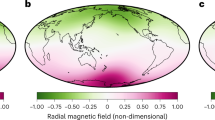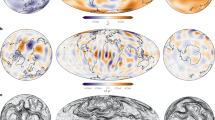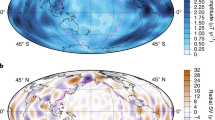Abstract
Temporal changes in the Earth’s magnetic field, known as geomagnetic secular variation, occur most prominently at low latitudes in the Atlantic hemisphere1,2 (that is, from −90 degrees east to 90 degrees east), whereas in the Pacific hemisphere there is comparatively little activity. This is a consequence of the geographical localization of intense, westward drifting, equatorial magnetic flux patches at the core surface3. Despite successes in explaining the morphology of the geomagnetic field4, numerical models of the geodynamo have so far failed to account systematically for this striking pattern of geomagnetic secular variation. Here we show that it can be reproduced provided that two mechanisms relying on the inner core are jointly considered. First, gravitational coupling5 aligns the inner core with the mantle, forcing the flow of liquid metal in the outer core into a giant, westward drifting, sheet-like gyre6. The resulting shear concentrates azimuthal magnetic flux at low latitudes close to the core–mantle boundary, where it is expelled by core convection and subsequently transported westward. Second, differential inner-core growth7,8, fastest below Indonesia6,9, causes an asymmetric buoyancy release in the outer core which in turn distorts the gyre, forcing it to become eccentric, in agreement with recent core flow inversions6,10,11. This bottom-up heterogeneous driving of core convection dominates top-down driving from mantle thermal heterogeneities, and localizes magnetic variations in a longitudinal sector centred beneath the Atlantic, where the eccentric gyre reaches the core surface. To match the observed pattern of geomagnetic secular variation, the solid material forming the inner core must now be in a state of differential growth rather than one of growth and melting induced by convective translation7,8.
This is a preview of subscription content, access via your institution
Access options
Subscribe to this journal
Receive 51 print issues and online access
$199.00 per year
only $3.90 per issue
Buy this article
- Purchase on Springer Link
- Instant access to full article PDF
Prices may be subject to local taxes which are calculated during checkout




Similar content being viewed by others
References
Jackson, A., Jonkers, A. R. T. & Walker, M. R. Four centuries of geomagnetic secular variation from historical records. Phil. Trans. R. Soc. Lond. A 358, 957–990 (2000)
Holme, R., Olsen, N. & Bairstow, F. L. Mapping geomagnetic secular variation at the core-mantle boundary. Geophys. J. Int. 186, 521–528 (2011)
Finlay, C. C. & Jackson, A. Equatorially dominated magnetic field change at the surface of Earth’s core. Science 300, 2084–2086 (2003)
Christensen, U. R., Aubert, J. & Hulot, G. Conditions for Earth-like geodynamo models. Earth Planet. Sci. Lett. 296, 487–496 (2010)
Buffett, B. Gravitational oscillations in the length of day. Geophys. Res. Lett. 23, 2279–2282 (1996)
Aubert, J. Flow throughout the Earth’s core inverted from geomagnetic observations and numerical dynamo models. Geophys. J. Int. 192, 537–556 (2013)
Monnereau, M., Calvet, M., Margerin, L. & Souriau, A. Lopsided growth of Earth’s inner core. Science 328, 1014–1017 (2010)
Alboussière, T., Deguen, R. & Melzani, M. Melting-induced stratification above the Earth’s inner core due to convective translation. Nature 466, 744–747 (2010)
Aubert, J., Amit, H., Hulot, G. & Olson, P. Thermochemical flows couple the Earth’s inner core growth to mantle heterogeneity. Nature 454, 758–761 (2008)
Pais, M. A. & Jault, D. Quasi-geostrophic flows responsible for the secular variation of the Earth’s magnetic field. Geophys. J. Int. 173, 421–443 (2008)
Gillet, N., Pais, M. A. & Jault, D. Ensemble inversion of time-dependent core flow models. Geochem. Geophys. Geosyst. 10, Q06004 (2009)
Olsen, N., Mandea, M., Sabaka, T. J. & Toffner-Clausen, L. The CHAOS-3 geomagnetic field model and candidates for the 11th generation IGRF. Earth Planets Space 62, 719–727 (2010)
Lesur, V., Wardinski, I., Hamoudi, M. & Rother, M. The second generation of the GFZ Reference Internal Magnetic Model: GRIMM-2. Earth Planets Space 62, 765–773 (2010)
Finlay, C. C., Jackson, A., Gillet, N. & Olsen, N. Core surface magnetic field evolution 2000–2010. Geophys. J. Int. 189, 761–781 (2012)
Fournier, A. et al. An introduction to data assimilation and predictability in geomagnetism. Space Sci. Rev. 155, 247–291 (2010)
Christensen, U. R. & Wicht, J. in Treatise on Geophysics Vol. 8, Core Dynamics (ed. Schubert, G. ) Ch. 8 (Elsevier, 2007)
Kuang, W. & Bloxham, J. An Earth-like numerical dynamo model. Nature 389, 371–374 (1997)
Sakuraba, A. & Roberts, P. H. Generation of a strong magnetic field using uniform heat flux at the surface of the core. Nature Geosci. 2, 802–805 (2009)
Miyagoshi, T., Kageyama, A. & Sato, T. Zonal flow formation in the Earth’s core. Nature 463, 793–796 (2010)
Christensen, U. R. & Olson, P. Secular variation in numerical geodynamo models with lateral variations of boundary heat flux. Phys. Earth Planet. Inter. 138, 39–54 (2003)
Glatzmaier, G. A. & Roberts, P. H. Rotation and magnetism of Earth’s inner core. Science 274, 1887–1891 (1996)
Buffett, B. A. & Glatzmaier, G. A. Gravitational braking of inner-core rotation in geodynamo simulations. Geophys. Res. Lett. 27, 3125–3128 (2000)
Aubert, J. & Dumberry, M. Steady and fluctuating inner core rotation in numerical geodynamo models. Geophys. J. Int. 184, 162–170 (2011)
Dumberry, M. Geodynamic constraints on the steady and time-dependent inner core axial rotation. Geophys. J. Int. 170, 886–895 (2007)
Gubbins, D., Sreenivasan, B., Mound, J. & Rost, S. Melting of the Earth’s inner core. Nature 473, 361–363 (2011)
Davies, C. J., Silva, L. & Mound, J. E. On the influence of a translating inner core in models of outer core convection. Phys. Earth Planet. Inter. 214, 104–114 (2013)
Olson, P. & Deguen, R. Eccentricity of the geomagnetic dipole caused by lopsided inner core growth. Nature Geosci. 5, 565–569 (2012)
Masters, G., Laske, G., Bolton, H. & Dziewonski, A. in Earth’s Deep Interior (eds Karato, S., Forte, A., Liebermann, R. C., Masters, G. & Stixrude, L. ) 63–87 (AGU Monograph Vol. 117, American Geophysical Union, 2000)
Helffrich, G. & Kaneshima, S. Outer-core compositional stratification from observed core wave speed profiles. Nature 468, 807–810 (2010)
Gubbins, D. & Davies, C. J. The stratified layer at the core-mantle boundary caused by baro-diffusion of oxygen, sulphur and silicon. Phys. Earth Planet. Inter. 215, 21–28 (2013)
Aubert, J., Labrosse, S. & Poitou, C. Modelling the palaeo-evolution of the geodynamo. Geophys. J. Int. 179, 1414–1428 (2009)
Lhuillier, F., Fournier, A., Hulot, G. & Aubert, J. The geomagnetic secular-variation timescale in observations and numerical dynamo models. Geophys. Res. Lett. 38, L09306 (2011)
Christensen, U. R. & Aubert, J. Scaling properties of convection-driven dynamos in rotating spherical shells and application to planetary magnetic fields. Geophys. J. Int. 166, 97–114 (2006)
Ahrens, T. J. Global Earth Physics: A Handbook of Physical Constants Vol. 1 (AGU, 1995)
Sabaka, T. J., Olsen, N. & Purucker, M. Extending comprehensive models of the Earth’s magnetic field with Oersted and CHAMP data. Geophys. J. Int. 159, 521–547 (2004)
Acknowledgements
This work was supported by the French Agence Nationale de la Recherche (grant ANR-2011-BS56-011). Numerical computations were performed at S-CAPAD, IPGP, France, and using HPC resources from GENCI-IDRIS (grants 2012-042122 and at 2013-042122). This is IPGP contribution 3419.
Author information
Authors and Affiliations
Contributions
J.A. designed the project and carried out the numerical experiments. J.A. and C.C.F. designed the numerical experiments and processed the results. J.A, C.C.F. and A.F. discussed the results and commented on the manuscript.
Corresponding author
Ethics declarations
Competing interests
The authors declare no competing financial interests.
Extended data figures and tables
Extended Data Figure 1 Energy spectra of the coupled Earth dynamo.
a, b, Earth-surface energy spectra for the magnetic field (a) and secular variation (b), as functions of spherical harmonic degree. The geomagnetic field model14 gufm-sat-Q3 in 2001 is given as a red line (corresponding to Fig. 2a, b), together with a snapshot of the coupled Earth dynamo model (solid black line, same time as Fig. 2c, d) and its time-averaged spectrum (dashed black line, averaging time is 67,000 years).
Extended Data Figure 2 Variations in the length of day arising from core–mantle angular momentum exchanges.
The optimal choice for the model gravitational coupling constant Γτ (Methods) is guided by inverting geomagnetic field model35 CM4 between 1960 and 2000, and model14 gufm-sat-Q3 between 2000 and 2010, for length-of-day variations (open circles), using an inverse geodynamo modelling framework (see figure 13 in ref. 6 and associated discussion for a full description of the method). The prior numerical dynamo models used in the framework (Extended Data Table 1) are G (green line) and GI (red line). A vanishing gravitational coupling results in vanishing length-of-day variations (blue line). Variations in Earth’s length of day of core origin (as computed in ref. 11) are represented in black.
Extended Data Figure 3 Effect of the inner-core boundary mass anomaly flux heterogeneity.
Time-averaged plots of azimuthal velocity in the equatorial plane (blue is westwards, grey arrows mark the general circulation) for models GI, GI1.2 and GI1.6 (respectively a–c, Extended Data Table 1) where the amplitude Δf/f of the inner-core boundary heterogeneity is varied. The grey half-circles represent the orientation of the hemispherical buoyancy release heterogeneity at the inner boundary. The location of the Greenwich meridian (0°) is also marked.
Extended Data Figure 4 Origin of the geographical localization of secular variation.
Longitudinally (a) and latitudinally (b) averaged profiles of the time average secular variation energy contained in models G, GI, GM, the standard and the coupled Earth dynamo models (Extended Data Table 1). Secular variation is filtered at spherical harmonic degree and order 8, as in Fig. 1.
Extended Data Figure 5 Analysis of longitudinal magnetic drift.
Shown is magnetic power coherently moving in the longitudinal direction, as a function of latitude and azimuthal speed. a, Analysis of the historical field model gufm1 following ref. 3. b, c, Same analysis, applied respectively to 3,000-year sequences of the coupled Earth and standard dynamo models, filtered at spherical harmonic degree and order 13. Power colour scale differs in a, b and c owing to the different timespans available in the dynamo models and the historical geomagnetic field model. The analysis is performed using the Radon transform technique (Supplementary Information).
Supplementary information
Supplementary Information
This file contains Supplementary Text and Data and additional references. (PDF 186 kb)
Magnetic field dynamics in the coupled Earth (CE) dynamo model.
Radial magnetic field (Hammer projection) at the core-mantle boundary of the CE dynamo model (orange is outwards, units in milliteslas), filtered at spherical harmonic degree 13, from the 3000-year simulation sequence presented in Figure 3a. (MOV 7492 kb)
Rights and permissions
About this article
Cite this article
Aubert, J., Finlay, C. & Fournier, A. Bottom-up control of geomagnetic secular variation by the Earth’s inner core. Nature 502, 219–223 (2013). https://doi.org/10.1038/nature12574
Received:
Accepted:
Published:
Issue Date:
DOI: https://doi.org/10.1038/nature12574
This article is cited by
-
The decrease in diurnal oxygen production in Elodea under the influence of high geomagnetic variability: the role of light, temperature and atmospheric pressure
International Journal of Biometeorology (2023)
-
An initial map of fine-scale heterogeneity in the Earth’s inner core
Nature Geoscience (2022)
-
Sustaining Earth’s magnetic dynamo
Nature Reviews Earth & Environment (2022)
-
Waves in planetary dynamos
Reviews of Modern Plasma Physics (2022)
-
Core Eigenmodes and their Impact on the Earth’s Rotation
Surveys in Geophysics (2022)
Comments
By submitting a comment you agree to abide by our Terms and Community Guidelines. If you find something abusive or that does not comply with our terms or guidelines please flag it as inappropriate.



